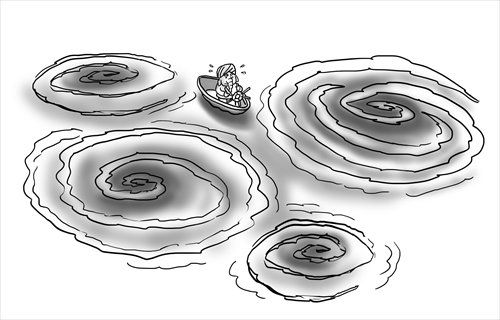HOME >> OP-ED
India’s Sino-US hedging sticks to old balance
By Shi Lancha Source:Global Times Published: 2016-4-28 20:03:01

Illustration: Liu Rui/GT
The recent twists and turns in the Sino-Indian relations have presented a somewhat puzzling picture to the world. Bilateral relations seem to oscillate back and forth drastically between outright confrontations and a united front. Clearly, with the partisan dynamics of domestic agendas as well as the political confidence reaped from various international scenarios, the National Democratic Alliance government under Narendra Modi's leadership has taken new initiatives in India's relations with the major powers.
While the lack of political leadership and ideological self-doubt regarding non-alignment hindered previous Indian governments, Modi is better positioned to maneuver nimbly and therefore take seemingly self-contradictory actions in his foreign policymaking.
In mid-February, a US military official revealed that the Indian Navy would join the US in patrolling South China Sea. Although the Indian side soon denied such joint patrols, Modi's government has clearly taken a bolder stance on China-related issues in the region than its predecessors. Not only did the Indian ambassador publicly articulate support for the Philippine's claims in the South China Sea arbitration case, Indian decision-makers also echoed the US, Japan, and Australia in hardening its position against China on the maritime disputes there.
On April 10, Ashton Carter, the US secretary of defense, arrived in India after cancelling a scheduled visit to China. During Carter's India's trip, a historic deal was reached "in principle" between two countries - the Logistics Support Agreement (LSA). This deal may help Indian military to operate beyond the subcontinent or the Indian Ocean, significantly strengthening its capacity of global military delivery.
But instead of a chill of the bilateral relations, China and India actually saw bilateral visits and negotiations happened on an unprecedented scale and frequencies.
Starting from April 16, Manohar Parrikar, Indian defense minister, initiated his five-day tour to China. Besides presenting the annual meeting of the Working Mechanism for Consultation and Coordination on the border and talking to top Chinese military leaders, he even went to the newly established Western Theater Command in charge of the border affairs with India.
Almost simultaneously, the 14th meeting of the foreign ministers of China, Russia and India was staged in Moscow on April 18, in which Indian Foreign Minister Sushma Swaraj held a comprehensive dialogue with Chinese Foreign Minister Wang Yi. Again, this was immediately followed by Indian National Security Advisor Ajit Doval's visit to China on April 20, in which he attended the 19th boundary talks and discussed the key bilateral issues with his counterpart Yang Jiechi.
Against the backdrop of a series of preceding ominous events, the Modi administration's newly staged three-way dialogue with the Chinese leadership involving the foreign minister, defense minister and national security advisor is actually revealing. While the previous UPA government led by Manmohan Singh was bogged down by rampant internal divisions and unable to act decisively, the Modi administration can now nimbly maneuver and pursue a more dramatic policy vis-a-vis China, even though sometimes such policies may appear self-contradictory or even paradoxical. Indian political commenter C. Raja Mohan's insightful words sum up this newly adopted posture, "Delhi seems ready to compete with Beijing where it must and cooperate where it can."
The Modi administration seems to revolutionize the traditional style of foreign policies, such as non-alignment and fence-sitting. However, all that has significantly changed is the "means" - the policy options and vehicles to carry out these options, rather than the "ends" - the fundamental ideas that pilot and condition the entire gamut of policy choices.Despite the Indian government's dramatic postures concerning major power relations, Modi actually maintains the old-school "balance of power" strategy. That's why Sino-Indian relations have seen a cascade of tensions that were unconventionally followed by another series of warm diplomatic exchanges.
Consciously or unconsciously, the latter series of events in effect hedged against the potential damage brought by the former to the Sino-Indian relations. Seen this way, Modi's China policy never turned in a different direction, instead, it has only swung back and forth more drastically. Sometimes it gets much colder than it usually appears, then warms up quickly to compensate the previous chill.
In New Delhi's calculation vis-à-vis China, swinging back and forth may well create strategic leverage that can be more effective than simply deferring to China's presumed opposition against India's interaction with a third party on the sensitive issues. For example, India might use the unsigned, draft LSA with the US to create some unconventional leverage in the three forthcoming meetings with Chinese leadership.
However, New Delhi also has to remember that such flip-flops on major power relations may also put itself in a difficult position. Considering that the low-hanging fruit, if there was any, has already been plucked, such strategy may amount to little at the end of the day.
The author is a visiting scholar at Tsinghua University. opinion@globaltimes.com.cn Follow us on Twitter @GTopinion
Posted in: Viewpoint